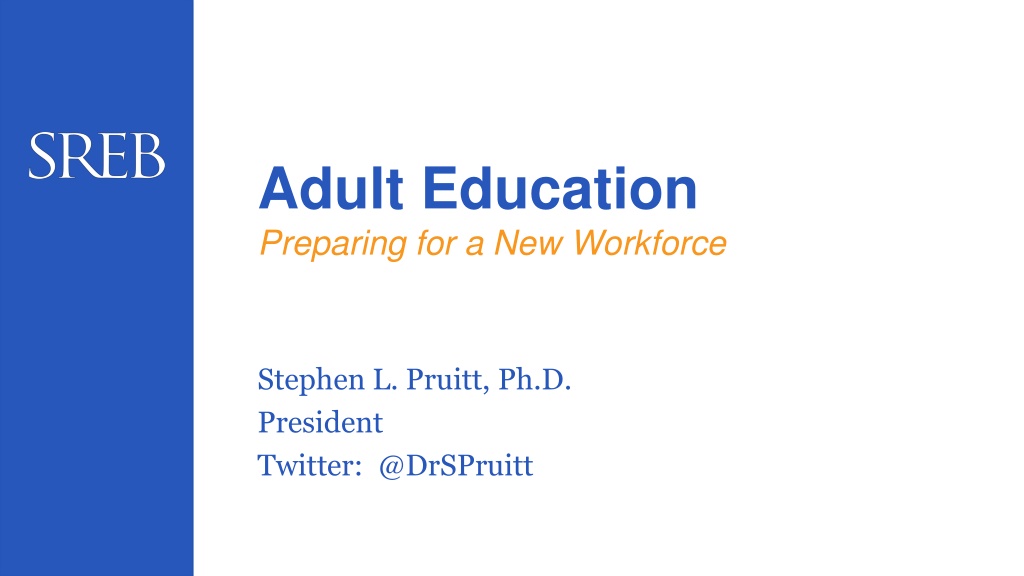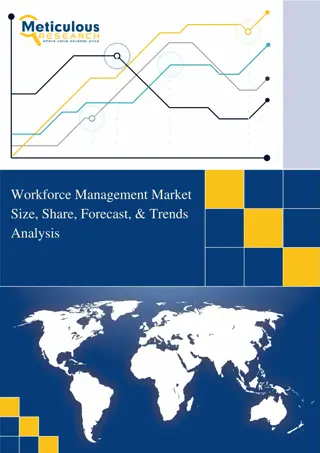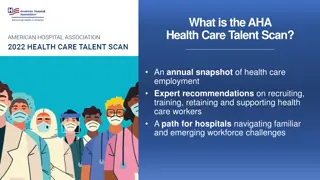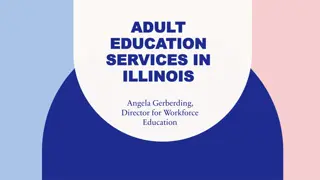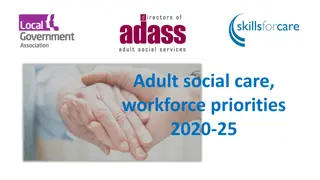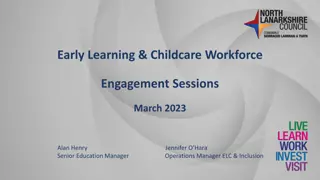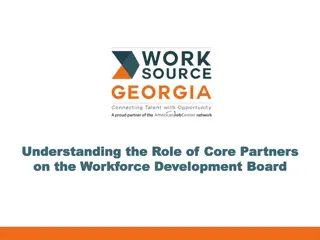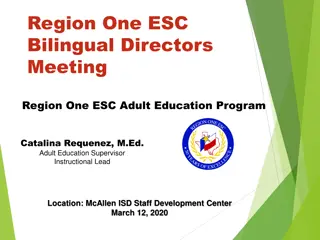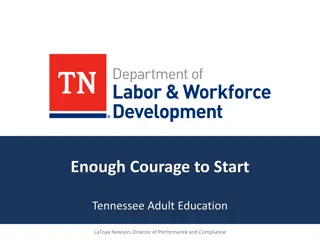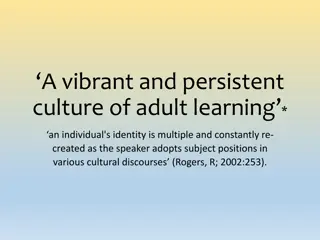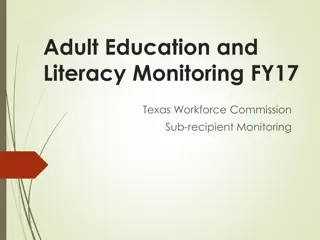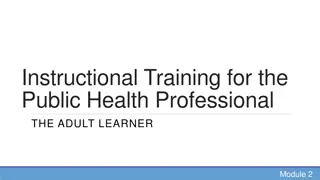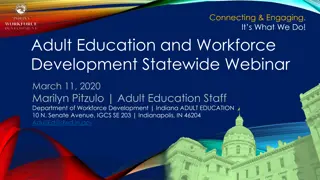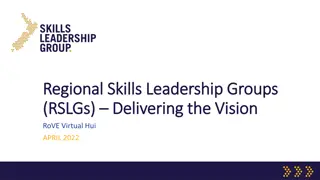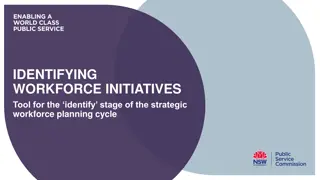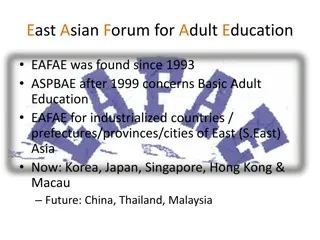Adult Education for a New Workforce - Preparing for Future Challenges
As the workforce landscape evolves, adult education plays a crucial role in preparing individuals for the changing demands of the job market. With statistics projecting a shift towards a more dependent population and increased automation potential in key industries, addressing these challenges becomes paramount. The pandemic has accelerated digital adoption, highlighting the need for upskilling and reskilling programs to ensure workforce sustainability and competitiveness.
Download Presentation

Please find below an Image/Link to download the presentation.
The content on the website is provided AS IS for your information and personal use only. It may not be sold, licensed, or shared on other websites without obtaining consent from the author. Download presentation by click this link. If you encounter any issues during the download, it is possible that the publisher has removed the file from their server.
E N D
Presentation Transcript
Adult Education Preparing for a New Workforce Stephen L. Pruitt, Ph.D. President Twitter: @DrSPruitt
2 Adult Education /Pruitt
A More Dependent Population By 2030, for every 52 dependent people in Georgia there will be just 48 working-age adults to provide for them. Under 25 25-64 65+ 2017 34% 53% 14% Under 25 25-64 65+ 2020 36% 51% 13% Under 25 25-64 65+ 2030 36% 48% 16% 3 Adult Education /Pruitt
4 Adult Education /Pruitt
5 Adult Education /Pruitt
6 Adult Education /Pruitt
Pre-Pandemic Total Automation Potential Work activities in the Top 5 Employing Industries (2014-2030) 64% 86% 42% 61% 69% Food Preparation and Serving Sales Office and Administrative Production Transportation 7 Adult Education /Pruitt
The pandemic advanced consumer and business digital adoption by an estimated five years in just eight weeks. 8 Adult Education /Pruitt
By 2025 no longer 2030 accelerated digital adoption due to the pandemic could eliminate the full-time equivalence of 389,000 positions at the most conservative rate, 1,295,000 positions at a midpoint rate, or 2,590,000 positions at the fastest estimated rate. 9 Adult Education /Pruitt
If just 50% of automation potential is realized, 15% of all work activities could be automated between 2020 and 2025. 14% 21% 29% 23% 20% Food Preparation and Serving Office and Administrative Sales Production Transportation 10 Adult Education /Pruitt
Percentage of the Workers that are Vulnerable During the Pandemic in Each Top 5 Industry 56% 6% 90% 70% 100% Food Preparation and Serving Sales Office and Administrative Production Transportation together, they make up almost one-third of the total workforce in Georgia. 11 Adult Education /Pruitt
Working Toward a Unified Vision
Setting Workforce North Star Required by Perkins V and WIOA Preparing and educated and skilled workforce States can add other goals under all three statutes Other goals aligned to the vision Required by Perkins V and WIOA Required by ESSA English and math, high school graduation rate and English proficiency Meeting the skilled workforce needs of employers 13 Adult Education /Pruitt
Ensure that your programs help everyone take part in achieving the vision Work-based learning Career pathways Equity Share labor market data Target the same set of in- demand industries Use a shared set of criteria and processes to develop high-quality pathways Get K-12 students involved earlier Collaborate on professional learning, plan together, share resources Coordinate support services Engage shareholders together Focus funds on WBL in the most in-demand fields Articulate what high- quality work-based learning looks like 14 Adult Education /Pruitt
Work-Based Learning Recommendations
Recommendations Process Engage business and industry leaders in forging and strengthening regional industry sector partnerships in support of career education. Prioritize state resources and efforts to develop career pathways in critical industry sectors as identify by regional business partnerships. Supportive Policies Adopt a business-friendly statewide policy for K-16 and work-based learning that promotes a continuum of experiences beginning in the middle grades and extending through postsecondary. Recognize the importance of work-based learning in high school by including those experiences in graduation requirements and high school accountability ratings. Provide policy solutions for workers' compensation and liability insurance for work-based learning placements. 16 Adult Education /Pruitt
Recommendations continued.. Funding Support industry sector partnerships by braiding funding from multiple sources federal, state, local, private and philanthropic. Provide incentives to employers offering paid work-based learning experiences. Tools and Mechanisms Promote Simulated Workplace and other virtual solutions to expand work-based learning opportunities in rural and hard-to-serve communities. Designate a state agency or special council to work with employers and secondary and postsecondary education agencies to identify, evaluate and approve industry certification examinations, technical skills assessments, dual credit courses and end-of-course assessments that are part of a system of stackable credentials. Promote structured dual enrollment programs for career pathways and establish uniform statewide policies so students can earn credits toward high school graduation that are automatically added to students transcripts at postsecondary institutions. . 17 Adult Education /Pruitt
Contact me: Stephen L. Pruitt, Ph.D. President Stephen.Pruitt@SREB.org Twitter: @DrSPruitt Southern Regional Education Board SREB.org
